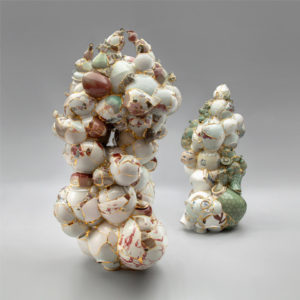May 31, 2014
Korean ceramic art exhibition at San Francisco International Airport showcases interplay of contemporary and traditional.
Download a PDF copy of this Press Release: English | 한국어 보도자료

SAN FRANCISCO, May 13, 2014—Travelers rushing through San Francisco International Airport (SFO) over the next nine months may want to take it slow. Doing so will allow them to enjoy Dual Natures in Ceramics: Eight Contemporary Artists from Korea, a special exhibition featuring 75 stunning contemporary artworks created by some of Korea’s most respected artists. On view May 17, 2014 through Feb. 22, 2015 at SFO’s Terminal 3, the exhibition features artworks that offer a modern twist to time-honored practices. Dual Natures is co-organized by the SFO Museum and the Asian Art Museum, and guest curated by Hyonjeong Kim Han, associate curator of Korean art, with assistance from Silvia Hari Chang, curatorial assistant of Korean art, and Chihyun Lee, Korea Foundation intern at the Asian Art Museum.
Korea has a long and proud ceramic tradition—jade green Korean celadons, for example, have been coveted the world over for centuries. Dual Natures explores the meaning and beauty of Korean ceramics in the 21st-century through artworks by Kim Yik-yung, Koo Bohnchang, Lee Inchin, Lee Kang Hyo, Park Young Sook, Roe Kyung Jo, Yeesookyung and Yoon Kwang-cho. For these pioneering artists, creating ceramic art has become second nature. While Korean ceramic art is rooted in tradition, the artists explore new concepts of interpretation, creating a dialogue between the traditional and contemporary.
Highlights of the exhibition include Mountain Dreams by Yoon Kwang-cho and Buncheong Bottle 63 by Lee Kang Hyo. Both artists reinterpret buncheong ceramics, a distinctive Korean ceramic popular in the 15th and 16th centuries that are decorated with white slip (a mixture of white clay and water). Both artists use the white slip in creative and innovative applications to form ceramics with whimsical, rustic and sometimes bold characteristics.
Kim Yik-yung and Park Young Sook were inspired by white ceramics of the Joseon dynasty (1392–1910). Kim designs innovative surface treatments and explores new glaze applications, as seen in Bowl. Also embracing core traditions of ceramics from the Joseon dynasty, Park infuses modern sensitivity with long-lost artistic customs in her blue-white ceramics, like bojagi (wrapping cloth) designs adapted on her ceramic plates.
Yeesookyung recreates ceramic sculptures by mending together discarded, broken ceramic pieces with 24K gold, probing the relationship of the fragmentary and imperfect with the whole and pure. She constructs free forms, unexpected shapes of intimate sculptures, which create life and meaning in the formerly discarded shards as seen in five of her Translated Vases.
Another highlight of the exhibition is Moon Rising III, by Koo Bohnchang. Moon Rising III displays a series of 12 consecutive photographs of white globe-shaped moon jars, symbolizing the months in a year. Each jar, distinctive in character and personality, harmonizes with the whole, suggesting the cycle of life. Koo also presents for the first time, a new video artwork featuring vessels from several museums, including the Asian Art Museum, that are transmuted and brought to life from two-dimensional to three-dimensional art forms.
The exhibition also features innovative ceramic techniques, which are apparent in the artworks of Roe Kyung Jo and Lee Inchin. Roe is known for his marbled-ware technique (yeollimun) that gives the effect of movement. As seen in Vase, Roe creates simple but animated forms and applies subtle decorations to his work, expressing elegant sensibility through clay. Onggi, a type of earthenware prior to porcelain production, was often used as containers in Korean kitchens. Lee Inchin started his works based on onggi wares but expands the techniques using new kinds of glaze and experimenting with its application.
The exhibition is located post-security and is only accessible to passengers ticketed for travel through San Francisco International Airport’s Terminal 3. There is no charge to view the exhibition.
The Asian Art Museum–Chong-Moon Lee Center for Asian Art and Culture is one of San Francisco’s premier arts institutions and home to a world-renowned collection of more than 18,000 Asian art treasures spanning 6,000 years of history. Through rich art experiences, centered on historic and contemporary artworks, the Asian Art Museum unlocks the past for visitors, bringing it to life while serving as a catalyst for new art, new creativity and new thinking. www.asianart.org
SFO Museum was established by the Airport Commission in 1980 for the purposes of humanizing the Airport environment, providing visibility for the unique cultural life of San Francisco, and providing educational services for the traveling public. The Museum was granted initial accreditation from the American Association of Museums in 1999, reaccredited in 2005, and has the distinction of being the only accredited museum in an airport. Today, SFO Museum features approximately twenty galleries throughout the Airport terminals displaying a rotating schedule of art, history, science, and cultural exhibitions, as well as the San Francisco Airport Commission Aviation Library and Louis A. Turpen Aviation Museum, a permanent collection dedicated to the history of commercial aviation. To browse current and past exhibitions, research our collection, or for more information, please visit www.flysfo.com/museum.
###